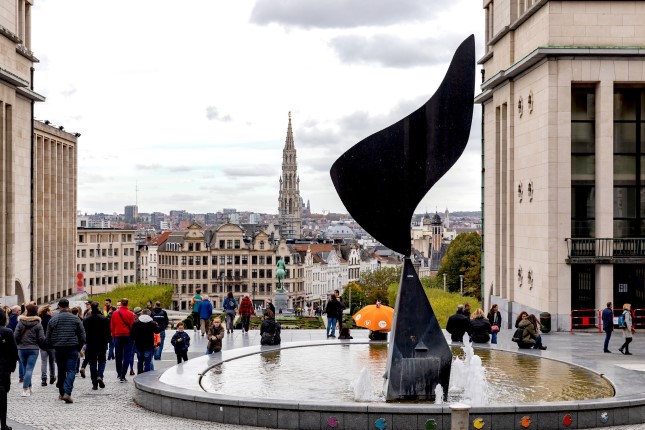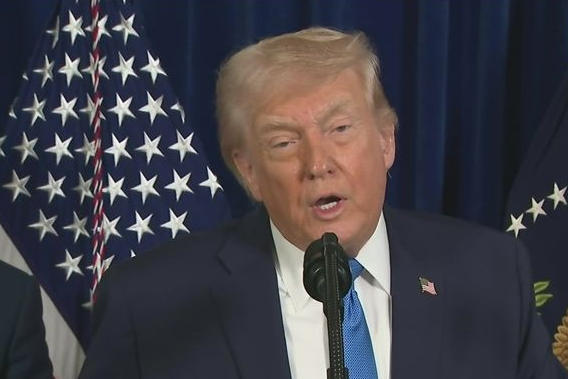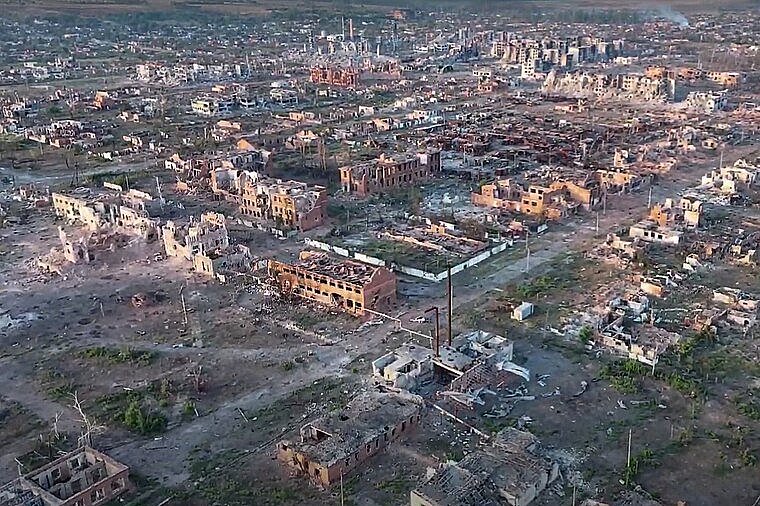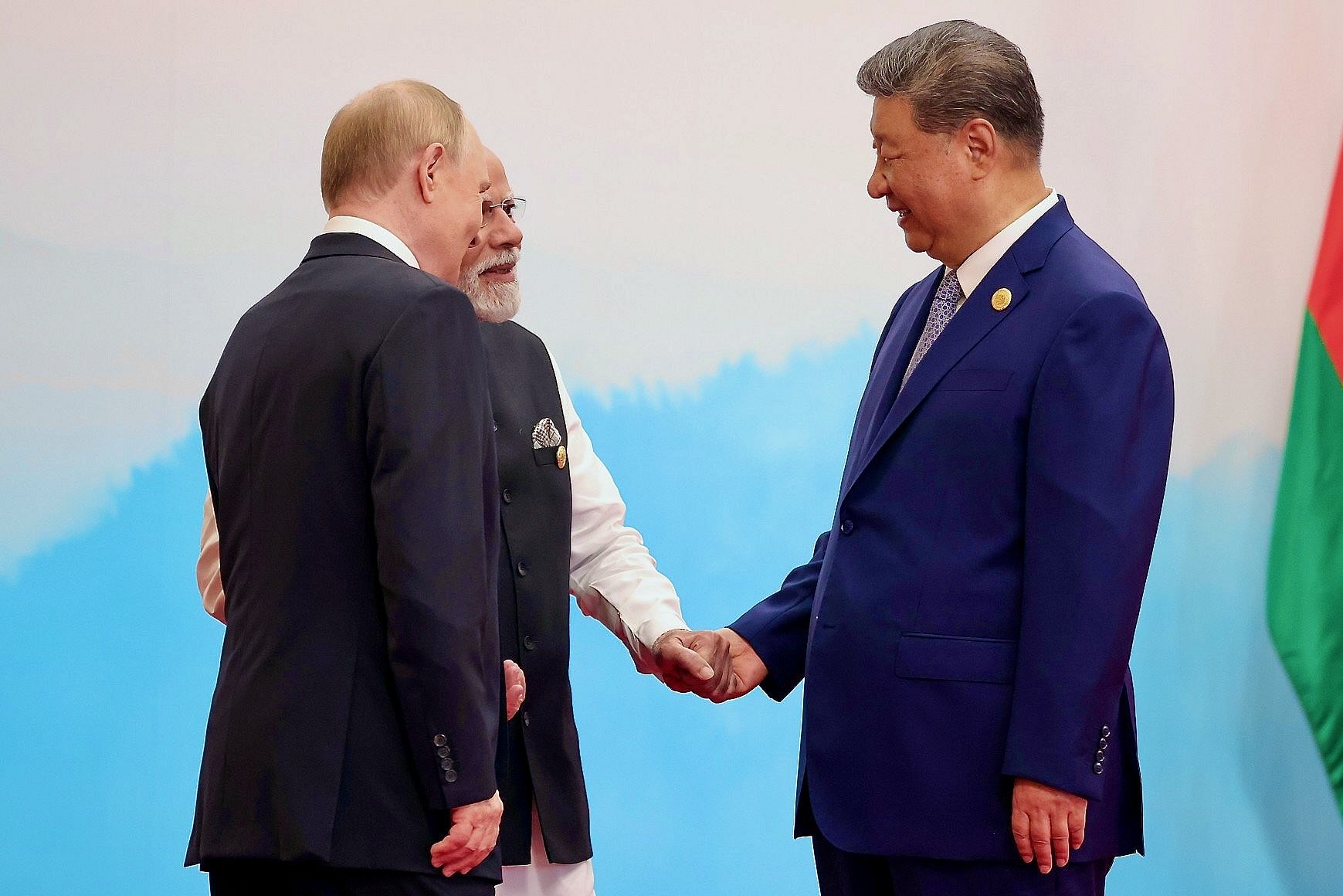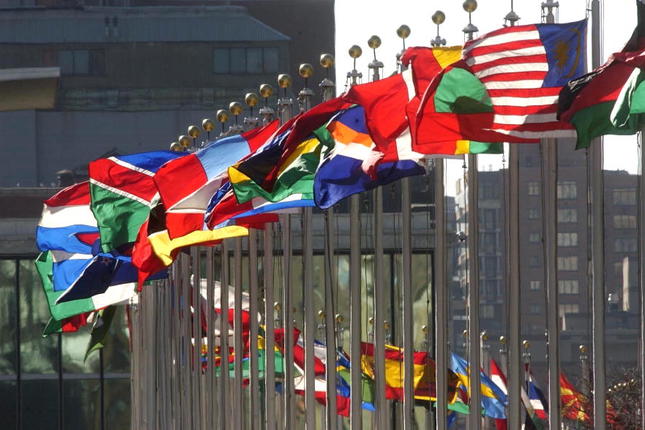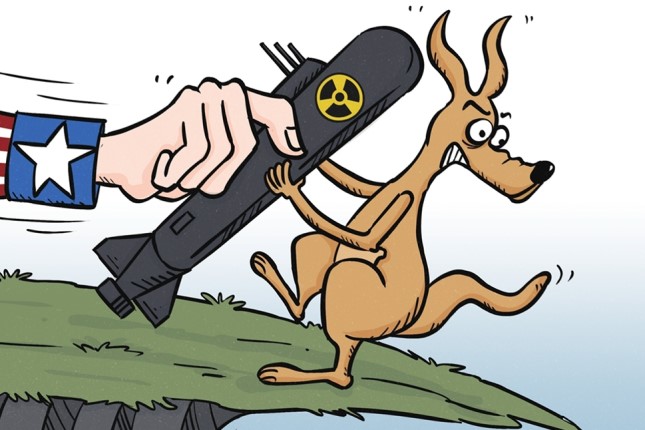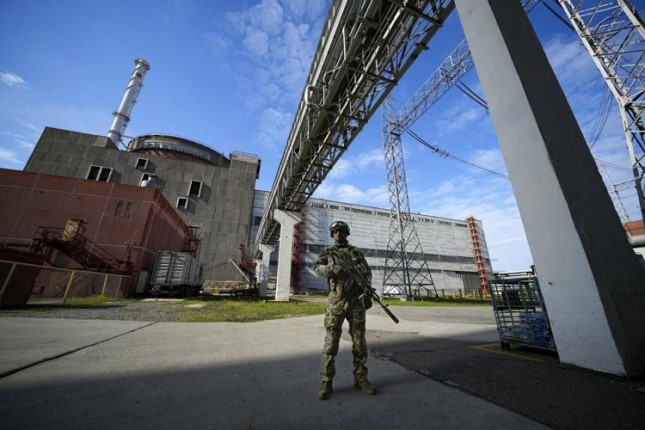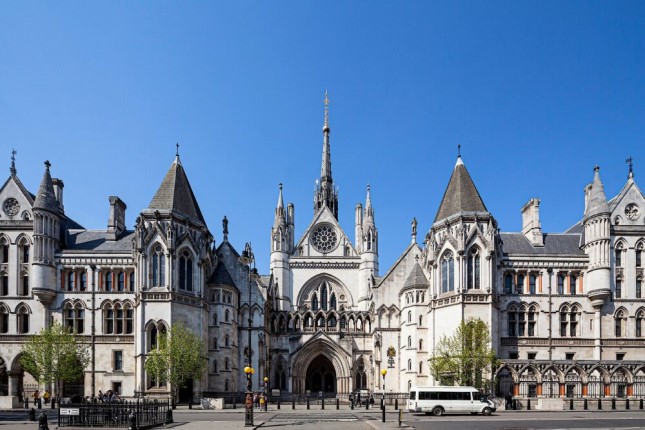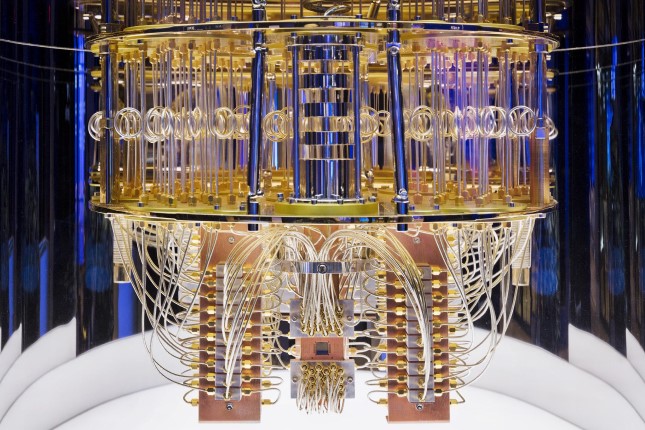Maybe you recall all the post–Cold War talk of a “peace dividend” and maybe you don’t: It depends on when you took up residence on this mortal coil.
The term arose as the Soviet Union disintegrated and was commonly mentioned during George H.W. Bush’s presidency, 1989–1993. A dramatic reduction in defense spending, and a corresponding increase in expenditures on education, health care, and so on, was put around as one of Bush I’s outstanding achievements. That was the peace dividend.
The thing you need to know about all the talk of a peace dividend back then is that it was all talk. And the thing you need to know now, with Cold War II in more or less full swing and the proxy war against Russia raging in Ukraine, is that there is no longer any need to know anything about the peace dividend.
As we speak, it takes its place as an artifact of another time, a curiosity in the way of … what? … maybe Eisenhower’s promise of free electricity in his “Atoms for Peace” speech, delivered at the United Nations in 1953.
The New York Times published a remarkable piece on this topic last week under the headline, “The ‘Peace Dividend’ Is Over in Europe. Now Come the Hard Tradeoffs.” There are two ways to read this lengthy report, text and subtext.
On one hand, it tells us exactly what the headline promises: European leaders, in response to the Ukraine crisis, now plan to dump a lot more money into the weapons of war and a lot less into the social-democratic apparatus — welfare programs, social programs, cultural programs — in which European citizens have long taken pride.
On the other, this piece has a special message for Americans: There shall be no more daydreaming about how good the Danes or the French have it. The military-industrial complex has crossed the Atlantic. Neoliberalism has won. It is indeed the end of history.
It is “TINA” time: “There is no alternative,” as Margaret Thatcher famously used to say. The future will be no different from the present.
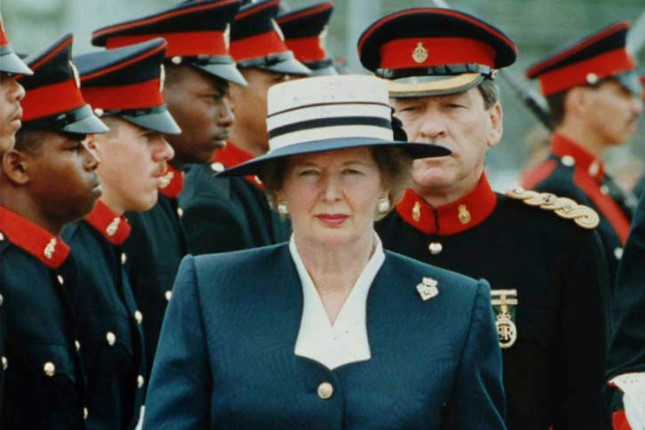
Margaret Thatcher reviewing the Royal Bermuda Regiment in early 1990. Photo: White House / Wikimedia Commons.
The equation seemed neat back in the early 1990s, ready-made for newspaper headlines: The Cold War’s end meant there would be no more need for all those missiles, lethal warheads, fighter jets and naval vessels. It would be fewer guns and more butter, to put the point simply.
I well recall some of those headlines, as I do the raised expectations of the many, many, many Americans who understood the price paid for the wild wastage of the Pentagon’s Cold War defense budgets.
Military Spending in US Economy
The peace dividend never arrived in America. This was fated to be, as the simple, guns-to-butter equation could not possibly have held. The base assumption was wrong. The Pentagon’s disgraceful bloat did not reflect security imperatives alone: If it did it would have had a greater degree of elasticity, growing or shrinking according to geopolitical conditions.
Missing in the equation is the place of defense spending in America’s political economy. It has long been a way to finance various kinds of technological innovation and keep defense contractors and the thousands of satellite companies supplying them profitable.
This has never been at all elastic. Remember, by the Cold War’s end all 435 congressional districts — this by design — had an interest of one or another kind in keeping the money flowing to the defense sector.
At first, the Bush I administration simply stopped talking about the peace dividend. Bill “Triangulate” Clinton then made his mark as president by gutting a great deal of our republic’s already pitiful social welfare provisions. And then, another memory: It fell to Colin Powell, Bush II’s secretary of state, to announce that the peace dividend was not to be and Americans should forget all about it.
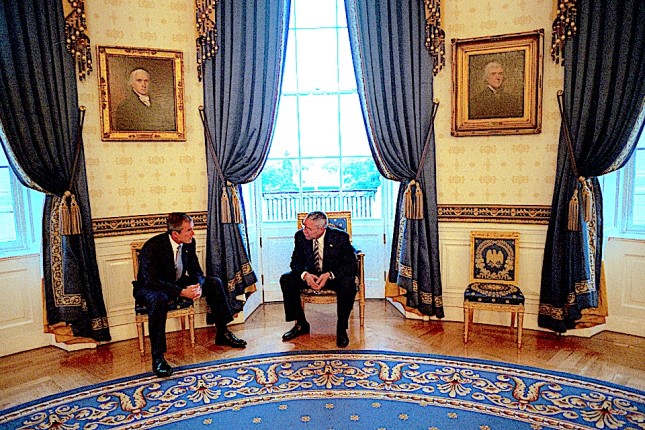
Sept. 20, 2001: President George W. Bush and U.S. Secretary of State Colin Powell in the White House. Photo: U.S. National Archives.
That was soon after the attacks of Sept. 11, 2001, and Bush II’s declaration of the war on terror. I can still see the headline on the Powell story on the front of The New York Times, lead of the paper that day. It put peace dividend in single quotation marks — ‘Peace Dividend’ — as if it were some strange, foolish idea.
In the best of the post–Cold War years, 1993 to 1999, the American defense budget flattened, no more. And flattened, given the immoral size of the Pentagon’s annual expenditures, did not do much for anybody.
But here’s the thing. There were quite impressive peace dividends in two other places. One was post–Soviet Russia, where defense spending collapsed. The other was Western Europe, where it did pretty much the same.
Public-sector expenditures rose precipitously — in many cases doubling — after Germans dismantled the Berlin Wall in November 1989. I was not at the time surprised, given Europeans’ reluctance to participate in America’s Cold War crusade in the first place.
These increases were sustained until last year. By 2014, meantime, military budgets reached what the Times calls a record low among NATO’s European members, although it does not make clear how this is measured.
And so to the current turn, the end of the party as described in last week’s New York Times piece.
Americanization
Europeans — well, some Europeans, no, make that a lot of Europeans — have been grousing about the Americanization of their way of life for decades, especially since America’s triumphalist 1990s: McDonald’s and Domino’s Pizza parlors all over the place, that vulgar Disney World outside of Paris, Costco and the other “big box stores,” all those infantilizing films coming over from Hollywood, the slobification of the Continent as standards of dress declined.
On the face of it, these seemed to be matters of mere taste. But more than taste has been at issue all these years. Behind all the demotic junk of America’s corporatized popular culture has been the creep of neoliberal austerity policies in finance ministries and among the technocrats in Brussels.
One of the remarkable features of America’s post–Cold War rendition of neoliberalism is that it can brook no deviation. If America worships markets, everybody must worship markets. If the U.S. lets a lust for profit destroy everything that gets in its way — culture, community, human dignity — everyone else must do the same.

Disney Land Paris, 2017. Photo: Benoît Prieur / CC0 / Wikimedia Commons.
Europeans are not inattentive to these questions. Remember José Bové, the Roquefort farmer who destroyed a McDonald’s in the Aveyron region of France at the end of the 1990s? He did that in the name of “slow food,” but, as Bové’s long record of activism attests, he is also a vigorous opponent of “globalization,” another term for neoliberalism in the American mode.
This same point applies to the recent protests against the Macron government’s pension reforms. The popular defense of French pensions stood for a defense against something much broader.
These controversies, these heat-producing frictions, have long been a defining feature of European political culture. Will Europe cave to America’s post–Cold War imperatives? This has been the question. And America’s neoliberal cliques, needless to say, have been heavily invested in this question.
How many times, I used to wonder in years gone by, do I have to read New York Times stories — the Times carried the spears on this front — telling me Sweden no longer works, or the French healthcare system — which the U.N. rates the world’s best, along with Japan’s — is falling apart?
After a time, this reader’s irritation gave way to sheer derision as the clerks who serve the reigning ideology, known euphemistically as correspondents, discredited themselves.
The Waning of Social Democracy
I read this just-published Times piece as the latest installment in this long story. It tells us that the “the peace dividend” — again it gets the quotation marks — was nothing more than an irresponsible holiday for the Europeans.
The long war is over (because another one has begun). Europe will no longer count as a worrisome alternative to America’s grim neoliberal realities, poisoning our minds with the thought that there are other ways to live.
The danger — that European social democracy, in all its various stripes, actually works — has passed. The Continent is now in for the whole nine, a war economy and the destruction of social-democratic programs being of a piece.
Until the Russian intervention in Ukraine last year, the Times reports, NATO’s European members planned to increase defense outlays by a modest 14 percent, to $1.8 trillion.
“Now, spending is estimated to rise between 53 and 65 percent,” we read. “That means hundreds of billions of dollars that otherwise could have been used to, say, invest in bridge and highway repairs, child care, cancer research, refugee resettlement or public orchestras is expected to be redirected to the military.”
“Bingo,” Patricia Cohen and Liz Alderman, who share the byline on this report, may as well have written. The two then indulge a weird, post–Cold War habit among American correspondents abroad. You may be in Paris or Berlin or wherever, but when you need a quotation to support your case, call an American who will tell you all about what is going on where you are, across one or another ocean.
So to a reliable neolib ideologue from way back, who professes at a reliable neolib institution: Cohen and Alderman write: “‘The spending pressures on Europe will be huge, and that’s not even taking into account the green transition,’” said Kenneth Rogoff, an economics professor at Harvard. “The whole European social safety net is very vulnerable to these big needs.”
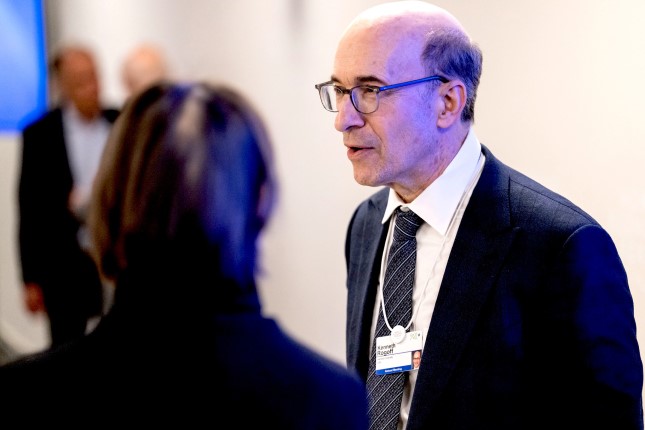
Kenneth Rogoff in January. Photo: World Economic Forum / Flickr / Mattias Nutt / CC BY-NC-SA 2.0.
It is impossible to miss the triumphalist gloat coursing through Cohen and Alderman’s prose. Read the piece. This caught my eye from the first paragraphs onward. It’s the military-industrial complex über alles — finally, thank goodness, etc.
“But in most of Europe,” the two write toward the end, “the painful budgetary trade-offs or tax increases that will be required have not yet trickled down to daily life.” This is an important point. What is going to happen when this case of “trickle down” finally trickles down?
There is no question that those purporting to represent Europeans are now quite strongly committed to “the American way” (if not necessarily truth and justice). The Stockholm International Peace Research Institute, SIPRI, issued a report late last month indicating that Europe’s defense spending rose in 2022 by the most in 30 years. Cohen and Alderman call this a “spendathon,” with evident approval.
But I am not so sure how Europeans will respond when they finally get their Colin Powell moment, when those running the show tell them their peace dividend is henceforth to be spent on the machinery of war and it is howitzers instead of hospitals, as the Times reporters put it.
Let us not forget: European societies are not so atomized as America’s, as I have noted previously in this space. Their political cultures still have some warp and woof to them.
John Pilger recently sent me a video of an interview he conducted with Martha Gellhorn late in her life. In it the late, great Gellhorn remarked, “I used to think people got the leaders they deserved. I no longer do.” This is the case in Europe today — if not, maybe, in politically somnambulant America.
The near term for Europeans is clear, set: They have been conscripted into Cold War II, like it or not. Nothing beyond this seems so certain to me. Let us hope Europeans prove able to keep a certain flame alive, the flame of possibility, and the piece I parse here turns out to be nothing more than another Sweden-doesn’t-work story.
Main photo: “The Whirling Ear” by Alexander Calder, Mont des Arts, Brussels, 2019 © Ninara / Flickr / CC BY 2.0.
Source: Consortium News.
